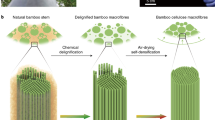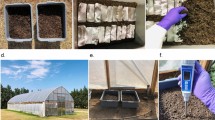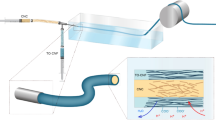Abstract
Developing high-performance bio-based fibres is highly desirable for improving the sustainability of materials. Cellulose is one of the most abundant bio-derived feedstocks to fabricate such materials. However, the fabrication of high-strength macro cellulose fibres is challenging due to the difficulty in obtaining ordered packing of cellulose molecular chains and nanocrystals in the macro-fibres. Here we develop a draw spinning/de-acetylation method to prepare cellulose fibres with highly ordered molecular packing that incorporates high strength in the obtained fibres. Specifically, a fibre draw spun from well-dispersed cellulose triacetate solution was de-acetylated to generate cellulose fibres, which were then twisted to spirally align the molecular chains. The resulting fibres exhibited mechanical strength of 3.08 GPa and toughness of 215.1 MJ m−3, much higher than existing fibre materials. This work paves the way to obtaining high-performance bio-based fibres.
This is a preview of subscription content, access via your institution
Access options
Access Nature and 54 other Nature Portfolio journals
Get Nature+, our best-value online-access subscription
$32.99 / 30 days
cancel any time
Subscribe to this journal
Receive 12 digital issues and online access to articles
$119.00 per year
only $9.92 per issue
Buy this article
- Purchase on SpringerLink
- Instant access to full article PDF
Prices may be subject to local taxes which are calculated during checkout




Similar content being viewed by others
Data availability
All data in this work are available in the text and the Supplementary Information. The relevant raw data for Supplementary Figs. 1–53 and Supplementary Tables 1–7 are provided in the Supplementary Data. Source data are available via Figshare at https://doi.org/10.6084/m9.figshare.28235333 (ref. 65).
References
Liao, X. et al. High strength in combination with high toughness in robust and sustainable polymeric materials. Science 366, 1376–1379 (2019).
Tu, H., Zhu, M., Duan, B. & Zhang, L. Recent progress in high-strength and robust regenerated cellulose materials. Adv. Mater. 33, e2000682 (2021).
Zhang, L., Leung, M. Y., Boriskina, S. & Tao, X. Advancing life cycle sustainability of textiles through technological innovations. Nat. Sustain. 6, 243–253 (2023).
Olivetti, E. A. & Cullen, J. M. Toward a sustainable materials system. Science 360, 1396–1398 (2018).
Fang, Z. et al. Critical role of degree of polymerization of cellulose in super-strong nanocellulose films. Matter 2, 1000–1014 (2020).
Pyun, K. R., Rogers, J. A. & Ko, S. H. Materials and devices for immersive virtual reality. Nat. Rev. Mater. 7, 841–843 (2022).
Jia, C. et al. From wood to textiles: top-down assembly of aligned cellulose nanofibers. Adv. Mater. 30, e1801347 (2018).
Hakansson, K. M. et al. Hydrodynamic alignment and assembly of nanofibrils resulting in strong cellulose filaments. Nat. Commun. 5, 4018 (2014).
Mittal, N. et al. Multiscale control of nanocellulose assembly: transferring remarkable nanoscale fibril mechanics to macroscale fibers. ACS Nano 12, 6378–6388 (2018).
Mittal, N. et al. Ion-specific assembly of strong, tough, and stiff biofibers. Angew. Chem. Int. Ed. 58, 18562–18569 (2019).
Mittal, N. et al. Ultrastrong and bioactive nanostructured bio-based composites. ACS Nano 11, 5148–5159 (2017).
Lee, T.-W., Han, M., Lee, S.-E. & Jeong, Y. G. Electrically conductive and strong cellulose-based composite fibers reinforced with multiwalled carbon nanotube containing multiple hydrogen bonding moiety. Compos. Sci. Technol. 123, 57–64 (2016).
Liu, W. et al. Eco-friendly post-consumer cotton waste recycling for regenerated cellulose fibers. Carbohydr. Polym. 206, 141–148 (2019).
Liu, X. et al. Fabrication and characterization of chemical crosslinked cellulose fiber by dissolving cellulose in alkali urea aqueous solvent. J. Appl. Polym. Sci. 140, e53533 (2022).
Uddin, A. J., Yamamoto, A., Gotoh, Y., Nagura, M. & Iwata, M. Preparation and physical properties of regenerated cellulose fibres from sugarcane bagasse. Text. Res. J. 80, 1846–1858 (2010).
Zhang, J., Tominaga, K., Yamagishi, N. & Gotoh, Y. Comparison of regenerated cellulose fibers spun from ionic liquid solutions with lyocell fiber. J. Fiber Sci. Technol. 76, 257–266 (2020).
Hauru, L. K. J., Hummel, M., Michud, A. & Sixta, H. Dry jet-wet spinning of strong cellulose filaments from ionic liquid solution. Cellulose 21, 4471–4481 (2014).
Liang, Q. et al. High-strength superstretchable helical bacterial cellulose fibers with a self-fiber-reinforced structure. ACS Appl. Mater. Interfaces 13, 1545–1554 (2021).
Michud, A., Hummel, M. & Sixta, H. Influence of molar mass distribution on the final properties of fibers regenerated from cellulose dissolved in ionic liquid by dry-jet wet spinning. Polymer 75, 1–9 (2015).
Sixta, H. et al. Ioncell-F: a high-strength regenerated cellulose fibre. Nord. Pulp. Pap. Res. J. 30, 43–57 (2015).
Hooshmand, S., Aitomäki, Y., Berglund, L., Mathew, A. P. & Oksman, K. Enhanced alignment and mechanical properties through the use of hydroxyethyl cellulose in solvent-free native cellulose spun filaments. Compos. Sci. Technol. 150, 79–86 (2017).
Hooshmand, S., Aitomaki, Y., Norberg, N., Mathew, A. P. & Oksman, K. Dry-spun single-filament fibers comprising solely cellulose nanofibers from bioresidue. ACS Appl. Mater. Interfaces 7, 13022–13028 (2015).
Shen, Y. et al. High velocity dry spinning of nanofibrillated cellulose (CNF) filaments on an adhesion controlled surface with low friction. Cellulose 23, 3393–3398 (2016).
Cai, Y. et al. Hierarchical assembly of nanocellulose into filaments by flow-assisted alignment and interfacial complexation: conquering the conflicts between strength and toughness. ACS Appl. Mater. Interfaces 12, 32090–32098 (2020).
Grande, R., Trovatti, E., Carvalho, A. J. F. & Gandini, A. Continuous microfiber drawing by interfacial charge complexation between anionic cellulose nanofibers and cationic chitosan. J. Mater. Chem. A 5, 13098–13103 (2017).
Toivonen, M. S. et al. Interfacial polyelectrolyte complex spinning of cellulose nanofibrils for advanced bicomponent fibers. Biomacromolecules 18, 1293–1301 (2017).
Zhang, K. & Liimatainen, H. Hierarchical assembly of nanocellulose-based filaments by interfacial complexation. Small 14, e1801937 (2018).
Zhao, H., Yang, Z. & Guo, L. Nacre-inspired composites with different macroscopic dimensions: strategies for improved mechanical performance and applications. NPG Asia Mater. 10, 1–22 (2018).
Spinks, G. M. Advanced actuator materials powered by biomimetic helical fiber topologies. Adv. Mater. 32, 1904093 (2020).
Hou, Y. et al. Strengthening and toughening hierarchical nanocellulose via humidity-mediated interface. ACS Nano 15, 1310–1320 (2021).
Gaminian, H. & Montazer, M. Carbon black enhanced conductivity, carbon yield and dye adsorption of sustainable cellulose derived carbon nanofibers. Cellulose 25, 5227–5240 (2018).
Nishiyama, Y., Langan, P. & Chanzy, H. Crystal structure and hydrogen-bonding system in cellulose Iβ from synchrotron X-ray and neutron fiber diffraction. J. Am. Chem. Soc. 124, 9074–9082 (2002).
Yue, H. et al. Determination of cross-sectional area of natural plant fibres and fibre failure analysis by in situ SEM observation during microtensile tests. Cellulose 26, 4693–4706 (2019).
Cai, J. et al. Dynamic self-assembly induced rapid dissolution of cellulose at low temperatures. Macromolecules 41, 9345–9351 (2008).
Wang, S., Lu, A. & Zhang, L. Recent advances in regenerated cellulose materials. Prog. Polym. Sci. 53, 169–206 (2016).
Zhu, K. et al. Mechanically strong multifilament fibers spun from cellulose solution via inducing formation of nanofibers. ACS Sustain. Chem. Eng. 6, 5314–5321 (2018).
Gasser, C. A. et al. Sequential lignin depolymerization by combination of biocatalytic and formic acid/formate treatment steps. Appl. Microbiol. Biotechnol. 101, 2575–2588 (2016).
Li, Y., Feng, Y., Sun, X. & He, Y. A sodium‐ion‐conducting direct formate fuel cell: generating electricity and producing base. Angew. Chem. Int. Ed. 56, 5734–5737 (2017).
Munekata, S. & Sobue, H. The single crystal of cellulose. Polym. Lett. 5, 1043–1045 (1967).
Song, J. et al. Processing bulk natural wood into a high-performance structural material. Nature 554, 224–228 (2018).
Gosline, J. M., Guerette, P. A., Ortlepp, C. S. & Savage, K. N. The mechanical design of spider silks: from fibroin sequence to mechanical function. J. Exp. Biol. 202, 3295–3303 (1999).
Li, Z. et al. Sustainable high-strength macrofibres extracted from natural bamboo. Nat. Sustain. 5, 235–244 (2021).
Dou, Y. et al. Artificial spider silk from ion-doped and twisted core-sheath hydrogel fibres. Nat. Commun. 10, 5293 (2019).
Elices, M., Plaza, G. R., Perez-Rigueiro, J. & Guinea, G. V. The hidden link between supercontraction and mechanical behavior of spider silks. J. Mech. Behav. Biomed. Mater. 4, 658–669 (2011).
Persson, N.-K., Martinez, J. G., Zhong, Y., Maziz, A. & Jager, E. W. H. Actuating textiles: next generation of smart textiles. Adv. Mater. Technol. 3, 1700397 (2018).
Li, H., Tang, Z., Liu, Z. & Zhi, C. Evaluating flexibility and wearability of flexible energy storage devices. Joule 3, 613–619 (2019).
Ma, Z. et al. Permeable superelastic liquid-metal fibre mat enables biocompatible and monolithic stretchable electronics. Nat. Mater. 20, 859–868 (2021).
Sayyed, A. J., Deshmukh, N. A. & Pinjari, D. V. A critical review of manufacturing processes used in regenerated cellulosic fibres: viscose, cellulose acetate, cuprammonium, LiCl/DMAc, ionic liquids, and NMMO based lyocell. Cellulose 26, 2913–2940 (2019).
Wang, D., Chen, Q., Hu, J., Fu, M. & Luo, Y. High flux recovery of copper(II) from ammoniacal solution with stable sandwich supported liquid membrane. Ind. Eng. Chem. Res. 54, 4823–4831 (2015).
Jiang, X., Bai, Y., Chen, X. & Liu, W. A review on raw materials, commercial production and properties of lyocell fiber. J. Bioresour. Bioprod. 5, 16–25 (2020).
Chatzi, E. G. & Koenig, J. L. Morphology and structure of Kevlar fibers: a review. Polym.-Plast. Technol. Eng. 26, 229–270 (1987).
Nataraj, S. K., Yang, K. S. & Aminabhavi, T. M. Polyacrylonitrile-based nanofibers—a state-of-the-art review. Prog. Polym. Sci. 37, 487–513 (2012).
Xia, L., Xi, P. & Cheng, B. A comparative study of UHMWPE fibers prepared by flash-spinning and gel-spinning. Mater. Lett. 147, 79–81 (2015).
Zhang, D. B., Liu, Z. F., Zhong, W. H., Qin, Z. M. & Xiao, Z. X. Preparation and structural behavior of high-performance PBO fibers. J. Phys. Conf. Ser. 2460, 012081 (2023).
Zhang, M., Niu, H. & Wu, D. Polyimide fibers with high strength and high modulus: preparation, structures, properties, and applications. Macromol. Rapid Commun. 39, 1800141 (2018).
Kane, A., Giraudet, S., Vilmain, J.-B. & Le Cloirec, P. Intensification of the temperature-swing adsorption process with a heat pump for the recovery of dichloromethane. J. Environ. Chem. Eng. 3, 734–743 (2015).
López, S. E. & Salazar, J. Trifluoroacetic acid: uses and recent applications in organic synthesis. J. Fluor. Chem. 156, 73–100 (2013).
Hyman, D. Mixing and agitation. Adv. Chem. Eng. 3, 119–202 (1962).
Lang, C. et al. Nanostructured block copolymer muscles. Nat. Nanotechnol. 17, 752–758 (2022).
Ahvenainen, P., Kontro, I. & Svedström, K. Comparison of sample crystallinity determination methods by X-ray diffraction for challenging cellulose I materials. Cellulose 23, 1073–1086 (2016).
Park, S., Baker, J. O., Himmel, M. E., Parilla, P. A. & Johnson, D. K. Cellulose crystallinity index: measurement techniques and their impact on interpreting cellulase performance. Biotechnol. Biofuels Bioprod. 3, 10 (2010).
Poletto, M., Ornaghi, H. L. & Zattera, A. J. Native cellulose: structure, characterization and thermal properties. Materials 7, 6105–6119 (2014).
Howell, C. et al. Effects of hot water extraction and fungal decay on wood crystalline cellulose structure. Cellulose 18, 1179–1190 (2011).
Ming, X. et al. 2D-topology-seeded graphitization for highly thermally conductive carbon fibers. Adv. Mater. 34, 2201867 (2022).
Liu, Z. Source_data.rar. Figshare https://doi.org/10.6084/m9.figshare.28235333 (2019).
Acknowledgements
This work was supported by the National Natural Science Foundation of China (grant nos. 52350120, 52225306, 52090034, 51973093, 51773094 and 22371300), the National Key Research and Development Program of China (grant no. 2022YFB3807100), Frontiers Science Center for New Organic Matter, Nankai University (grant no. 63181206), the Fundamental Research Funds for the Central Universities (grant no. 63171219), Lingyu Grant (2021-JCJQ-JJ-1064), Beijing-Tianjin-Hebei Basic Research Cooperation Project (no. J230023), Tianjin Science and Technology Program (no. 22JCYBJC01260), Tianjin Basic Application Research Project (22JCYBJC01260), and Anhui Provincial Science and Technology Innovation Tackling Program (no. 202423i08050057). This work was also supported by the User Experiment Assist System of Shanghai Synchrotron Radiation Facility (SSRF), Beijing Synchronization Radiation Facility (BSRF), the Institute of Tianjin Seawater Desalination and Multipurpose Utilization.
Author information
Authors and Affiliations
Contributions
Z.L., X.Z., M.Z. and K.Y. designed the experiments. Z.L., X.Z., M.Z., K.Y., C.L., W. Gu, M.W., J.L., K.W., Y.X., S.L., Y.L., W. Guo, W.Z., J.B., D.Y. and Y.Z. performed most of the experiments, participated in analysis of the results and co-wrote the paper. All authors contributed to the general discussion and reviewing of the paper.
Corresponding authors
Ethics declarations
Competing interests
The authors declare no competing interests.
Peer review
Peer review information
Nature Sustainability thanks Marco Beaumont, Xiaoming Tao and Haipeng Yu for their contribution to the peer review of this work.
Additional information
Publisher’s note Springer Nature remains neutral with regard to jurisdictional claims in published maps and institutional affiliations.
Supplementary information
Supplementary Information
Supplementary Figs. 1–53, Tables 1–7 and Videos 1 and 2.
Supplementary Video 1
Continuous spinning of a single CTF.
Supplementary Video 2
Continuous spinning of multiple CTFs.
Supplementary Data
Supplementary Data.
Rights and permissions
Springer Nature or its licensor (e.g. a society or other partner) holds exclusive rights to this article under a publishing agreement with the author(s) or other rightsholder(s); author self-archiving of the accepted manuscript version of this article is solely governed by the terms of such publishing agreement and applicable law.
About this article
Cite this article
Yu, K., Li, C., Gu, W. et al. High-strength cellulose fibres enabled by molecular packing. Nat Sustain 8, 411–421 (2025). https://doi.org/10.1038/s41893-025-01523-x
Received:
Accepted:
Published:
Issue date:
DOI: https://doi.org/10.1038/s41893-025-01523-x
This article is cited by
-
Interface-Engineered Self-Healing Quasi-solid Fiber Battery with High Energy Density and Robust Mechanical Properties
Advanced Fiber Materials (2025)



